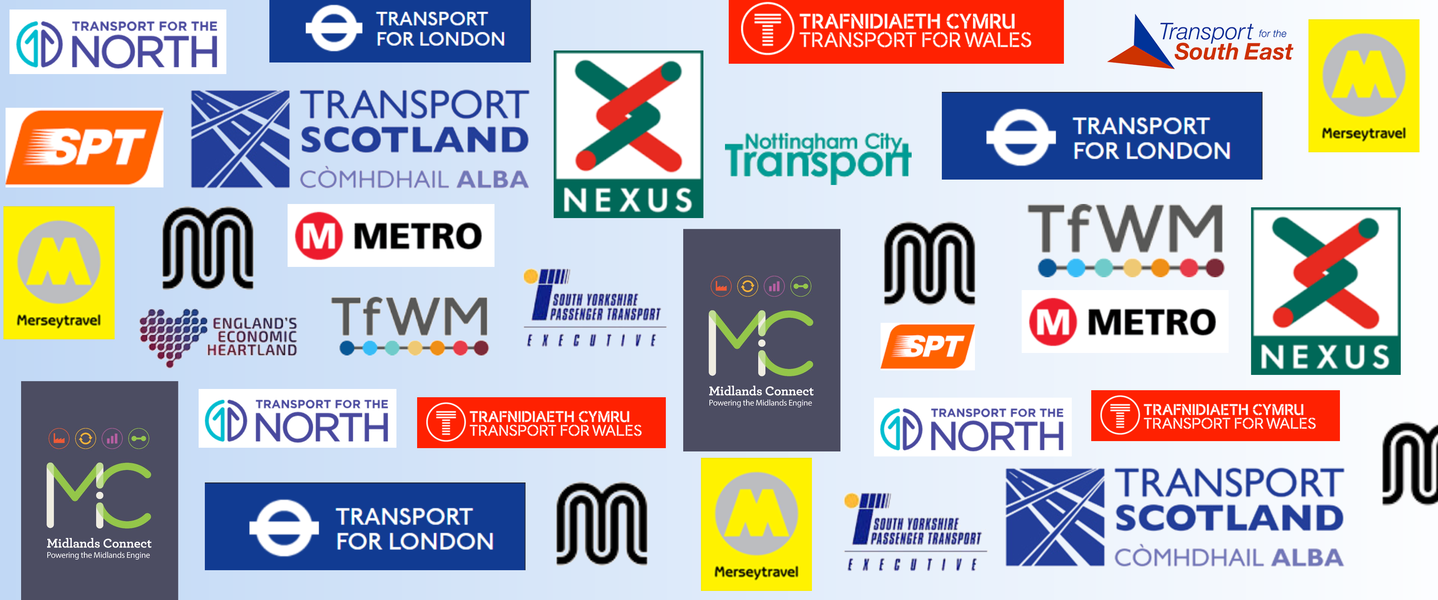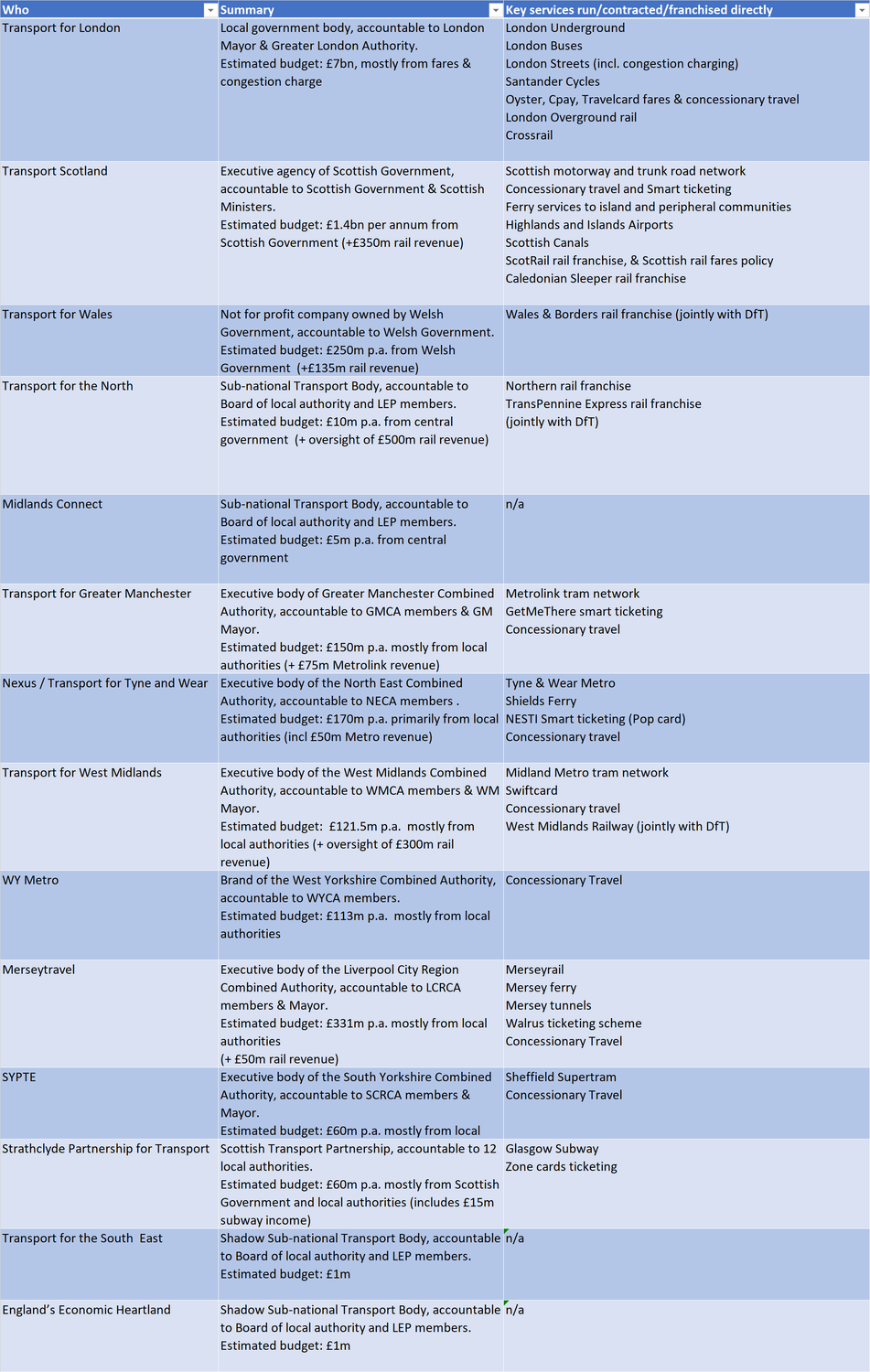Published on September 2, 2018

I've done a few projects recently for Transport for the North (TfN), which often leads to questions from peers along the lines of 'what is TfN?', 'is that the same sort of thing as TfL?' or indeed 'how many of these Transport for Somewhere bodies are there?'.
Frequently there is an assumption that because the name is similar, the role and powers must be similar.
Most people snooze off after the first 10 seconds of explanation, but for those that are interested this article should save the need to keep explaining.
No two are the same
There are quite a range of local transport bodies constituted in different ways, with differing roles, powers, funding sources and governance structures.
London
By most measures the largest and with the broadest in remit is Transport for London (TfL). Accountable to the Greater London Authority and London Mayor, TfL provides a range of services (directly and contracted), as well as setting the strategic transport vision for London. Most of it's revenue comes from fares and congestion charging.
Devolved nations
Transport Scotland probably has the next widest scope - as an executive agency of the Scottish Government it is accountable to Scottish Ministers. Responsibilities include trunk road network, rail franchising, concessionary fares, canals and airports. Most of its funding comes from Scottish Government (who in-turn have tax raising powers).
It might be reasonable to expect Transport for Wales therefore to mirror this - but Welsh and Scottish devolution are different. Transport for Wales is a 'not for profit' company owned by the Welsh Government, and effectively the delivery mechanism for specific strategic transport initiatives in Wales. The main focus to-date has been the letting of the Wales and Borders franchise.
Sub-national Transport Bodies
Transport for North is the first of a series of planned 'Sub-national Transport Bodies' (SNTB). Accountable to a board of Local Authority and Local Enterprise Partnership (LEP) representatives, the primary focus is on long-term strategic transport planning across a geography wider than individual local authorities, but smaller than a nation. Simplistically they exist to provide a unified voice to central government articulating the strategic transport investment case for their region - actual funding still comes from central Government. Typically SNTBs only have limited day-to-day roles - albeit TfN jointly manages the Northern and Transpennine rail franchises with the DfT, and is directly implementing a smart ticketing scheme.
Other SNTB bodies in varying stages of development include Midlands Connect, Transport for the South East, and Englands Economic Heartland, amongst others. Their roles are likely to be tailored to their local issues.
(Former) Passenger Transport Executives
It seems to be a mute point as to whether the term 'passenger transport executive' is still correct, but these bodies have their origins in the former PTEs, and whilst their roles (and sometimes geographic coverage) have changed - still have much in common.
Transport for Greater Manchester is an executive body of Greater Manchester Combined Authority, and much like TfL has a range of operational and strategic roles, including running Manchester Metrolink tram network, concessionary travel and 'getmethere' smart ticketing. Funding primarily comes from local authorities, and Metrolink fares.
Merseytravel is an executive body of Liverpool City Region Combined Authority, and again has a range of operational and strategic roles, including the Merseyrail Electrics rail network, the Mersey Ferry, concessionary travel , and 'Walrus' smart ticketing system. Funding primarily comes from local authorities, and Merseyrail fares.
Nexus - which now seems to be using the strap-line 'Transport for Tyne and Wear' - is an executive body of the North East Combined Authority, with a portfolio including Tyne & Wear Metro, Sheilds Ferry, concessionary travel, and NESTI smart ticketing system. Funding primarily comes from local authorities, and Metro fares.
SYPTE (South Yorkshire) - is an executive body of Sheffield City Region Combined Authority, with a portfolio including Sheffield Supertram, and concessionary travel amongst other things. Funding primarily comes from local authorities.
Transport for the West Midlands is an executive body of the West Midlands Combined Authority, with a portfolio including Midland Metro tram network, and the Swiftcard smart ticketing system. Through West Midlands Rail it also jointly manages the West Midlands rail franchise with the DfT for services within the West Midlands. Funding primarily comes from local authorities.
West Yorkshire Metro now exists only as a brand, with the former WYPTE run as part of the West Yorkshire Combined Authority. Funding primarily comes from local authorities.
Strathclyde Partnership for Transport had a change to its remit and Governance with the establishment of Transport Scotland - but still runs the Glasgow Subway, and Zonecard ticketing system amongst other things. Funding primarily comes from local authorities and subway fares.
Others
There are a range of other transport agencies of varying prominence - whether they are part of a single authority, such as Nottingham, or collaboration of authorities such as West of England - a common feature, is they're all at least slightly different.
Summary
In summary, don't read too much into the name.
